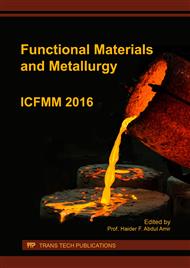[1]
Nanoengineering surface. Edited N.C. Lyakhov, S.G. Psakhie. Novosibirsk: Publishing House of SB RAS, (2008). p.276.
Google Scholar
[2]
Zh.M. Blednova, N.A. Makhutov, P.O. Rusinov. Рrospects for the use of shape memory materials to form multifunctional coatings on products of machine-building purposes. Factory Laboratory. Diagnosis materials. 79. № 11. (2013) pp.49-56.
Google Scholar
[3]
Alloy of nickel titanium shape memory. Part I. The structure, phase transformations and properties. Edited by V.G. Pushin. Ekaterinburg: UB of RAS, (2006). p.438.
Google Scholar
[4]
Zh.M. Blednova, D.G. Budrevich. Mechanical features of fatigue behavior of materials with a reversible phase structure. The scientific basis for improving low-cycle strength. Ed. N.A. Makhutov. Moscow: Science, (2006). pp.268-298.
Google Scholar
[5]
D.Y. Li. Development of novel tribo-composites with TiNi shape memory alloy matrix. Wear. 255. (2003). рр. 617–628.
DOI: 10.1016/s0043-1648(03)00116-9
Google Scholar
[6]
S.Y. Tarasov. Study tribological properties of NiTi. Advanced Materials. № 5. (19). рp. 24-30.
Google Scholar
[7]
Ni Wangyang, Yang-Tse Cheng. Novel layered tribological coatings using a superelastic NiTi interlayer Wear. 259, Issues 7-12, (2005). pp.842-848.
DOI: 10.1016/j.wear.2005.01.015
Google Scholar
[8]
Li D.Y., Rong Liu. The mechanism responsible for high wear resistance of Pseudo-elastic TiNi alloy – a novel tribo-material / Wear. 1999. V. 225–229. P. 777–783.
DOI: 10.1016/s0043-1648(98)00388-3
Google Scholar
[9]
Zh.M. Blednova, M.I. Chaevsky, A.N. Shauro. Research contact and cycle life in a reverse friction. Factory Laboratory. 11. (2000). pp.82-85.
Google Scholar
[10]
Zh.M. Blednova, P.O. Rusinov. Mechanical and Tribological Properties of the Composition Steel - nanostructured Surface Layer of a Material with Shape Memory Effect Based TiNiCu,. Applied Mechanics and Materials. 592-594. (2014). pp.1325-1330.
DOI: 10.4028/www.scientific.net/amm.592-594.1325
Google Scholar
[11]
Wangyang Ni, Yang-Tse Cheng, Michael Lukitsch, Anita M. Weiner, Lenoid C. Lev, David S. Grummon, Novel layered tribological coatings using a superelastic NiTi interlayer, Wear. Volume 259, Issues 7–12, (2005) p.842–848.
DOI: 10.1016/j.wear.2005.01.015
Google Scholar
[12]
A.I. Potekaev, V.A. Khokhlov, S.V. Galsanov. The nature and mechanisms of abrasive wear of shape memory materials on the example of NiTi. Bulletin of the Tomsk Polytechnic University. 321. 2. (2012). pp.107-111.
Google Scholar
[13]
A.C. McKelvey Ricthie, R.O. Fatigue-crack growth behavior in the superelastic and shape-memory alloy Nitinol. Metallurgical and Materials Transactions A. 32A. 3. (2001). pp.731-743.
DOI: 10.1007/s11661-001-1008-7
Google Scholar


